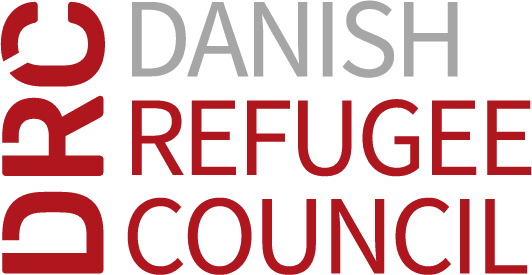

Diaspora Toolkit: Advocacy Toolkit for Diaspora Humanitarian Organizations
23 January 2024
As transnational actors with connections in both the country of origin and the country of residence, diaspora organizations are in a unique position in terms of advocacy.
This guide covers:
• Key components of advocacy
• 5 advocacy steps
• Advocacy tools and techniques
• Useful resources
What is advocacy?
Advocacy is "the act of pleading or arguing in favour of something, such as a cause, idea, or policy; active support". Advocacy can be defined as a process of supporting and enabling people to:
1. express their views and concerns
2. access information and services
3. defend and promote their rights and responsibilities
4. explore choices and options
Advocacy can be understood as an organized effort to influence social or policy change, whereby action can be directed towards both political decision-makers or society as a whole. Outcomes of advocacy may aim for change in policy and practice, change in public attitudes or behavior, change at the political, institutional, legal levels or to empower disadvantaged groups.
Key components:
1. Acting on behalf of people
2. Influencing and changing policy
3. Adopting strategies and applying techniques
4. Safeguarding lives
5. Raising public awareness
Why this DEMAC Toolkit?
The DEMAC toolkit, with 5 pocket guides, intends to offer practical guidance to support diaspora organizations in their humanitarian response and enhance coordination with diaspora and the humanitarian institutional system.
The toolkit is informed by DEMAC lessons learnt, consultations and good practices on diaspora humanitarianism. It provides guidance for diaspora responders and sets the framework for increasing understanding, knowledge and capacity in humanitarian response.
The toolkit does not intend to provide a binding, predetermined list of interventions or types of activities that may or may not be implemented, as this is dependent on the specific context and would appear overly prescriptive. We encourage adaptation of this resource to your local context.
With this toolkit we intend to offer practical guidance to support diaspora organizations in their humanitarian response.
Advocacy in emergency contexts
Advocacy as a critical and complementary means of ensuring effective protection for communities in emergency contexts. Advocacy in emergency is a means to address the humanitarian imperative.
Humanitarian action is guided by the fundamental humanitarian principles of humanity, neutrality, impartiality and independence. It is grounded in the desire for effective implementation of international humanitarian, refugee and human rights law.
Advocacy is crucial to any emergency response in order to amplify people’s voices, to ensure that responses are appropriate to people’s needs and rights and to ensure that they respect humanitarian principles.
It may relate to, for instance, protection, access, promoting good practice of humanitarian and development work, prevention of escalation of violence, conflict transformation and promoting nation/society-building as part of reconstruction and rehabilitation.

Advocacy Process
Step 1: PROBLEM
The purpose of Step 1: Identify the problem
The difficulty in identifying the problem often relates to the fact that we forget to distinguish between: the context of the problem, the effects of the problem, and the root causes of the problem.
The solution is therefore to analyze the problem and distinguish between its different aspects. It can be supported by using the suggested tools (see Problem tree on the right), to identify causes and consequences. The result is a clearer identification of the problem.
Suggested Tools
PROBLEM TREE: to work out the likely causes and consequences of your advocacy

Step 2: WHAT CHANGE do you want?
The purpose of Step 2: Identify the change we would like to see
By having a clear vision of the change that we wish to see, it is easier to identify our goals, both long and short term. In this way, it is easier to measure if we have succeeded or not.
It can be helpful to start by planning the end date of the advocacy plan (Backwards Planning) to set the main changes we would like to see, and then add subgoals as steps along the way to reach it. When having these goals listed, it can support the process of making your Theory of Change which is a comprehensive description and illustration of how and why a desired change is expected to happen in a particular context. Example: “when we do x and y, we will reach z”.
For this to succeed, we need to clarify our possibilities, analyze our Strengths, Weaknesses, Opportunities, and Threats (SWOT analysis) or conduct a Specific, Measurable, Achievable, Realistic, and Timely analysis (SMART analysis). Perhaps this analysis will lead to a new Theory of Change sentence.
Suggested tools
BACKWARD PLANNING: planning with the end date of the advocacy plan
SWOT ANALYSIS: a method for identifying and analyzing internal Strengths and Weaknesses and external Opportunities and Threats that shape current and future operations and help develop strategic goals
SMART GOALS: Specific, Measurable, Achievable, Realistic, and Timely Analysis
THEORY OF CHANGE: comprehensiveS description and illustration of how and why a desired change is expected to happen in a particular context

Step 3: TARGETS
The purpose of Step 3: Identify who has the power
To fulfill our goals, which we have just identified, we need to clarify who has the power to facilitate the process.
Differentiate between allies (support), neutrals (not for or against) and opponents (against).
Use mapping to outline your allies, neutrals or opponents. We can also map out our primary and secondary
targets. e.g who is close to the policy maker that we can influence? (this being the secondary target)
Suggested tools
POWER & STAKEHOLDER MAPPING will help you map the power dynamics at play to identify your primary target and design a winning campaign strategy
SPECTRUM OF ALLIES AND OPPONENTS to locate allies and opponents along a spectrum from active opposition to active allies in order increase your own support, as well as shift support out from under your opponent
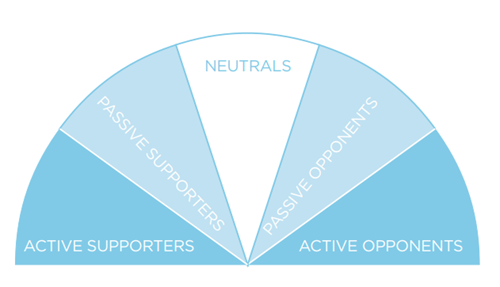
Step 4: STRATEGY FOR ACTION
The purpose of Step 4: Identify your strategies
Time for action! Depending on the target that we have identified, we must clarify how to act in the best way.
The aim is to design & choose our techniques to act. The tools are for campaign activities but can be used as inspiration to assure your strategies and actions.
• Is it realistic?
• Are there enough resources?
• What are the challenges to succeed?
Talk about the problems and solutions in your actions. Also make subgoals to achieve your main goal.
The ways of influencing are numerous: advocate, organize a target group, make actions, social media campaigns or a combination. In that way, the choice of actions is up to your targets.
Suggested tools
ACTION STAR: a checklist of 8 key factors for planning and evaluating actions
MIDWEST STRATEGY CHART: campaign roadmap to help decide what steps to take and when
BEAUTIFUL TROUBLE GAME: 10 games to get creatively unstuck, design an action, or plan a winning campaign
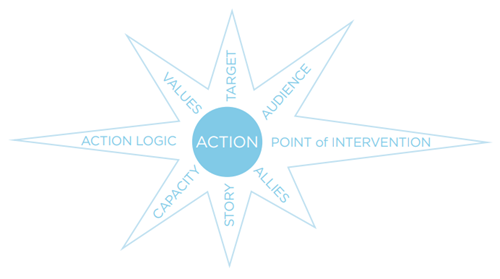
Types of Strategies


Examples of advocacy techniques
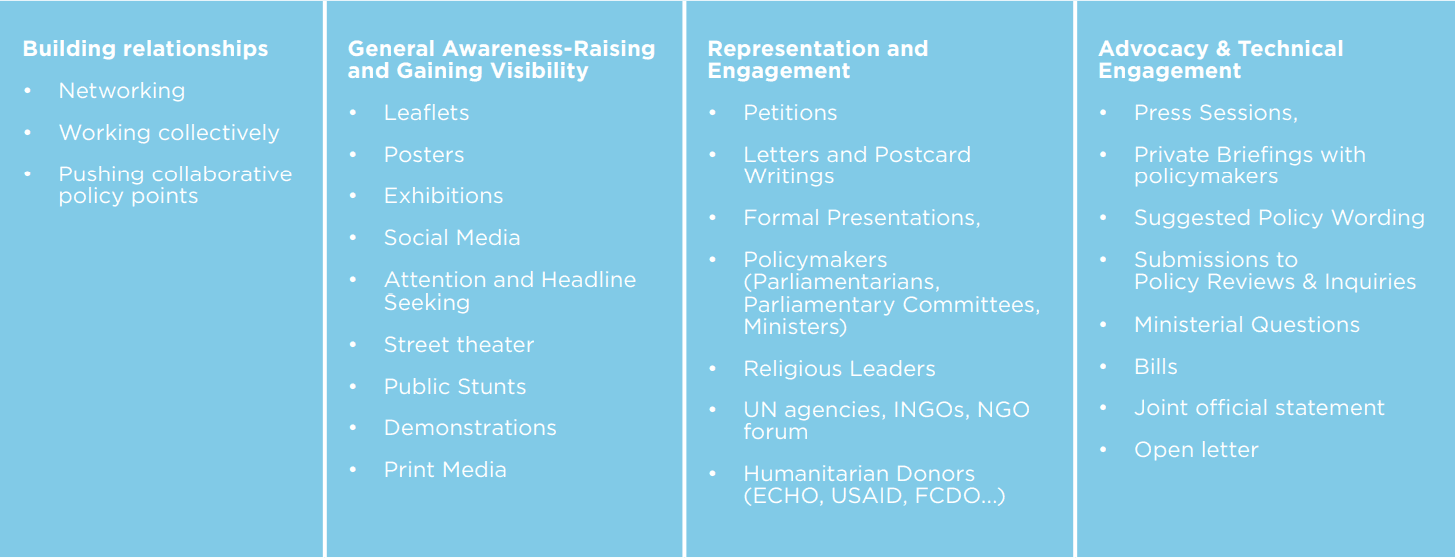
Step 5: TIMELINE
The purpose of Step 5:
Make a realistic timeline for main steps forward The aim is to structure everything clarified in the previous steps with dates, subgoals (and locations if possible) to keep an overview when we act.
Suggested tools
TIMELINE diagrams present events during specific intervals shown chronologically along a line. These events may be important milestones in a campaign.
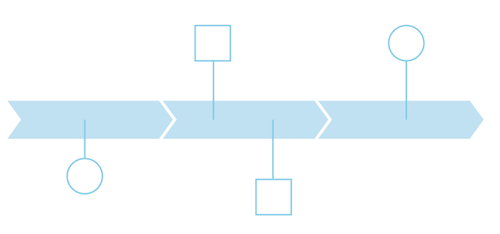
Useful resources for advocacy
• DRC Diaspora Toolkit is an advocacy toolkit that has been designed for diaspora organizations
• Beautiful Trouble provides an online Toolbox for grassroots and social change actors with concrete examples in 8 languages
• The Commons Social Change Library is an online collection of educational resources on campaign strategy, community organizing, digital campaigning, communications and media, working effectively in groups, fundraising, diversity and inclusion and much more
• The INTRAC Advocacy Toolkit is a concise guide to advocacy intended specifically for use by small nongovernmental organizations (NGOs) and produced as part of the Strengthening Small Organizations with Big Ambitions project (2021-22). It can be used by any small NGO which aims to strengthen its ability to advocate for change
• NGO Connect is a website site of Strengthening Civil Society Globally (SCS Global) dedicated to connecting and strengthening civil society organizations, networks and support organizations worldwide
• Power Shift Network Resource Bank is a crowd-sourced compendium of all the movement’s best tools and trainings capturing methods for community building, storytelling, coalition building, fundraising and much more
• Straight to the point advocacy tool provides clear, concise guidance to develop an advocacy initiative by setting advocacy priorities, assessing the political environment for advocacy and mapping an advocacy strategy
That could also interest you

Diaspora Toolkit: 5 Pocket Guides for Institutional Humanitarian Actors
Learn how to better understand diasporas and their way of working and collaborating.

Diaspora Toolkit: 5 Pocket Guides for Diaspora Organizations
Learn how to better understand humanitarian concepts and the way of working with humanitarian actors.

Stepping Up Amidst Crisis: Syrian Diaspora's Earthquake Response
DEMAC launches new Report on Syrian Diaspora's Earthquake Response in Northwest Syria




